Genesis of the Gongjuelong Sn Polymetallic Deposit in the Yidun Terrane, China: Constraints from the In Situ Geochemistry of Garnet, Cassiterite, and Quartz
Abstract
1. Introduction
2. Geological Setting
3. Ore Deposit Geology
4. Sampling and Analytical Methods
4.1. Electron Probe Micro-Analysis (EPMA)
4.2. Laser Ablation Inductively Coupled Plasma Mass Spectrometry (LA-ICP-MS)
5. Results
5.1. Major Elements of Garnet and Cassiterite
5.1.1. Garnet
5.1.2. Cassiterite
5.2. In Situ Trace Elements of Garnet, Cassiterite, and Quartz
5.2.1. Garnet
5.2.2. Cassiterite
5.2.3. Quartz
6. Discussion
6.1. Substitution Mechanisms
6.1.1. Garnet
6.1.2. Cassiterite
6.1.3. Quartz
6.2. Geochemistry Significance of the Garnets
6.3. Genetic Model and Implications for Exploration
7. Conclusions
- The two types of garnet in the Gongjuelong Sn deposit, Grt-I and Grt-II, are part of the solid solution series of grossular and andradite and reflect an initially reducing ore-forming environment. The ore-forming environment shifted from a moderately acidic reducing to a weakly reducing neutral environment during the transition from Grt-I to Grt-II.
- The trace element contents of garnet, cassiterite, and quartz from the Gongjuelong Sn deposit suggest that the Sn mineralization is favored by the reducing conditions developed by or around the magma intrusions. The quartz in this deposit formed at relatively high temperatures. The ore-forming fluid evolved from early-stage, high-temperature, reducing, moderately acidic fluids associated with garnet indicates that the Gongjuelong deposit is a proximal skarn deposit.
- The magmatic–hydrothermal system in the central Yidun Terrane is centered on the Late Cretaceous reduced, highly differentiated granites. The system includes proximal skarn Sn deposits and distal hydrothermal vein-type Pb–Zn–Ag±Sn deposits. Further exploration should focus on identifying Pb–Zn–Ag mineralization and rare metal mineralization in distal, structurally controlled areas. The locations of Pb–Zn mineralization could serve as pathfinders for hindered Sn deposits at depth.
Supplementary Materials
Author Contributions
Funding
Data Availability Statement
Acknowledgments
Conflicts of Interest
References
- Mulshaw, S.C.; Puig, C.; Spiro, B.; Buchanan, D.L. Genesis of epizonal Ag vein mineralization at San Bartolome in central Ecuador; textural evidence, fluid inclusions, and stable isotope geochemistry. Econ. Geol. 1997, 92, 210–227. [Google Scholar] [CrossRef]
- Meinert, L.D.; Dipple, G.M.; Nicolescu, S. World Skarn Deposits. In Economic Geology 100th Anniversary Volume; Hedenquist, J.W., Thompson, J.F.H., Goldfarb, R.J., Richards, J.P., Eds.; Society of Economic Geologists: Littleton, CO, USA, 2005; pp. 299–336. [Google Scholar]
- Welch, E.B.; Cooke, G.D. Internal phosphorus loading in shallow lakes: Importance and control. Lake Reserv. Manag. 2005, 21, 209–217. [Google Scholar] [CrossRef]
- Li, Y.J.; Wei, J.H.; Tan, J.; Fu, L.B.; Li, H.; Ke, K.J. Albian–Cenomanian A-type granite-related Ag–Pb–Zn veins in the central Yidun Terrane, SW China: Constraints from the Xiasai deposit. Miner. Depos. 2019, 55, 1047–1070. [Google Scholar] [CrossRef]
- Li, Y.J.; Zhang, R.Q.; Ji, H.; Wang, C.; Tan, J.; Wei, J.H. Chemistry and U–Pb geochronology of cassiterite in the Xiasai deposit, central Yidun Terrane (SW China): Link between Sn and Ag–Pb–Zn mineralisation. Ore Geol. Rev. 2022, 149, 105106. [Google Scholar] [CrossRef]
- Chen, Y.-K.; Ni, P.; Pan, J.-Y.; Cui, J.-M. Tracing the magmatic-hydrothermal evolution of the Xianghualing tin-polymetallic skarn deposit, South China: Insights from LA-ICP-MS analysis of fluid inclusions. Miner. Depos. 2024, 59, 1553–1578. [Google Scholar] [CrossRef]
- Qu, X.M. Metallogenic geological characteristics of the Lianlong skarn-type Sn-Ag polymetallic deposit in western Sichuan Province. Acta Geol. Sin. 2001, 22, 29–34. [Google Scholar]
- Qu, X.M.; Hou, Z.Q.; Zhou, S.G. Geochemical and Nd, Sr isotopic study of the post-orogenic granites in the Yidun arc belt of northern Sanjiang region, southwestern China. Resour. Geol. 2002, 52, 163–172. [Google Scholar] [CrossRef]
- Quan, L. Geological characteristics and genesis of Xiasai silver-polymetallic deposit in western Sichuan Province. Miner. Depos. 2003, 22, 121–128. [Google Scholar]
- Lin, F.C.; Yang, J.R.; Chen, C.D.; He, X.G.; Lin, Q.; Lu, Y.X.; Liu, Y.C.; Xie, E.S. Potentiality and assessment of Cu–Ag–Pb–Zn–Sn mineral resources in the Yidun metallogenic belt. Acta Geol. Sichuan 2003, 23, 141–144. [Google Scholar]
- Lin, Q. Geological features and prospecting potential for the Xialong Ag–Pb–Zn deposit in Batang, Sichuan. Acta Geol. Sichuan 2010, 30, 447–449. [Google Scholar]
- Lin, Q. Geological features and prospecting criteria for the Jiaogenma Sn–Zn deposit in Litang, Sichuan. Acta Geol. Sichuan 2011, 31, 37–40. [Google Scholar]
- He, X.G.; Li, S.H.; Xie, E.S. Geological features and prospecting potential for the Shaxi Ag–Pb–Zn deposit, Batang, Sichuan. Acta Geol. Sichuan 2004, 24, 77–81. [Google Scholar]
- Ying, H.L.; Wang, D.H.; Fu, X.F. Timing and lead and sulfur isotope composition of Xiasai granite and silver polymetallic deposit in Batang, Sichuan Province. Kuangchuang Dizhi (Miner. Depos.) 2006, 25, 135–146. [Google Scholar]
- Hou, Z.Q.; Zaw, K.; Pan, G.T.; Mo, X.X.; Xu, Q.; Hu, Y.Z.; Li, X.Z. Sanjiang Tethyan metallogenesis in SW China: Tectonic setting, metallogenic epochs and deposit types. Ore Geol. Rev. 2007, 31, 48–87. [Google Scholar] [CrossRef]
- Zou, G.; Zheng, R.; Hu, S. Geological features of the Xiasai silver-polymetallic deposit in West Sichuan, China. J.-Chengdu Univ. Technol. 2008, 35, 93. [Google Scholar]
- Fan, X. Geological features, ore-formation and mineralization zonation of the Hailong-Cuomolong skarn type Sn-polymetallic deposit in Batang, Sichuan. Acta Geol. Sichuan 2009, 29, 112–123. [Google Scholar]
- Zhang, C.Q.; Wu, Y.; Wang, D.H.; Chen, Y.C.; Rui, Z.Y.; Lou, D.B.; Chen, Z.H. Brief introduction on metallogeny of Pb–Zn deposits in China. Acta Geol. Sin. 2014, 88, 2252–2268. [Google Scholar]
- Zhang, D.Q.; Jiang, B.; Wang, D.H.; Wang, C.H.; Chen, Y.C.; Bai, G. A summary of resources characteristic and metallogenic regularity of silver deposits in China. Acta Geol. Sin. 2015, 89, 1008–1025. [Google Scholar]
- Zhang, J.B.; Ding, J.H.; Nan, G.L. The characteristics and potential of tin resources in China. Geol. China 2015, 42, 839–852. [Google Scholar]
- Chen, Z.H.; Wang, D.H.; Sheng, J.F.; Ying, L.J.; Liang, T.; Wang, C.H.; Liu, L.J.; Wang, Y.L. The metallogenic regularity of tin deposits in China. Acta Geol. Sin. 2015, 89, 1026–1037. [Google Scholar]
- Reid, A.; Wilson, C.J.; Shun, L.; Pearson, N.; Belousova, E. Mesozoic plutons of the Yidun Arc, SW China: U/Pb geochronology and Hf isotopic signature. Ore Geol. Rev. 2007, 31, 88–106. [Google Scholar] [CrossRef]
- Wang, Q.W.; Wang, K.M.; Kan, Z.Z.; Fu, X.F. Granites and Associated Minerogenetic Series of Ore Deposits in Western Sichuan Province; Geological Publishing House: Beijing, China, 2008. [Google Scholar]
- Hou, Z.Q.; Qu, X.M.; Zhou, J.; Yang, Y.; Huang, D.; Lu, Q.; Tang, S.; Yu, J.; Wang, H.; Zhao, J. Collision-orogenic processes of the Yidun arc in the Sanjiang region: Record of granites. Acta Geol. Sin. Chin. Ed. 2001, 75, 497–505. [Google Scholar]
- Deng, J.; Wang, Q.; Li, G.; Santosh, M. Cenozoic tectono-magmatic and metallogenic processes in the Sanjiang region, southwestern China. Earth-Sci. Rev. 2014, 138, 268–299. [Google Scholar] [CrossRef]
- Chen, J.L.; Xu, J.F.; Ren, J.B.; Huang, X.X. Late Triassic E-MORB-like basalts associated with porphyry Cu-deposits in the southern Yidun continental arc, eastern Tibet: Evidence of slab-tear during subduction? Ore Geol. Rev. 2017, 90, 1054–1062. [Google Scholar] [CrossRef]
- Zeng, P.S.; Li, W.C.; Wang, H.P.; Li, H. The Indosinian Pulang superlarge porphyry copper deposit in Yunnan, China: Petrology and chronology. Acta Petrol. Sin. 2006, 22, 989–1000. [Google Scholar]
- Meng, J.Y.; Yang, L.Q.; Lu, L.; Gao, X.; Li, J.X.; Luo, Y.Z. Re-Os dating of molybdenite from the Hongshan Cu-Mo deposit in Northwest Yunnan and its implications for mineralization. Acta Petrol. Sin. 2013, 29, 1214–1222. [Google Scholar]
- Peng, T.P.; Zhao, G.C.; Fan, W.M.; Peng, B.X.; Mao, Y.S. Zircon geochronology and Hf isotopes of Mesozoic intrusive rocks from the Yidun terrane, Eastern Tibetan Plateau: Petrogenesis and their bearings with Cu mineralization. J. Asian Earth Sci. 2014, 80, 18–33. [Google Scholar] [CrossRef]
- Wang, B.Q.; Zhou, M.F.; Li, J.W.; Yan, D.P. Late Triassic porphyritic intrusions and associated volcanic rocks from the Shangri-La region, Yidun terrane, Eastern Tibetan Plateau: Adakitic magmatism and porphyry copper mineralization. Lithos 2011, 127, 24–38. [Google Scholar] [CrossRef]
- Wang, B.Q.; Zhou, M.F.; Chen, W.T.; Gao, J.F.; Yan, D.P. Petrogenesis and tectonic implications of the Triassic volcanic rocks in the northern Yidun Terrane, Eastern Tibet. Lithos 2013, 175, 285–301. [Google Scholar] [CrossRef]
- Wang, B.Q.; Wang, W.; Chen, W.T.; Gao, J.F.; Zhao, X.F.; Yan, D.P.; Zhou, M.F. Constraints of detrital zircon U–Pb ages and Hf isotopes on the provenance of the Triassic Yidun Group and tectonic evolution of the Yidun Terrane, Eastern Tibet. Sediment. Geol. 2013, 289, 74–98. [Google Scholar] [CrossRef]
- Deng, J.; Wang, Q.F.; Li, G.J. Superimposed orogeny and composite metallogenic system: Case study from the Sanjiang Tethyan belt, SW China. Acta Petrol. Sin. 2016, 32, 2225–2247. [Google Scholar]
- Hou, Z.Q.; Yang, Y.Q.; Qu, X.M.; Huang, D.; Lu, Q.; Wang, H.; Yu, J.; Tang, S. Tectonic evolution and mineralization systems of the Yidun arc orogen in Sanjiang region, China. Acta Geol. Sin.-Chin. Ed. 2004, 78, 109–120. [Google Scholar]
- Li, W.C.; Pan, G.T.; Hou, Z.Q.; Mo, X.X.; Wang, L.Q.; Zhang, X.F. Metallogenic Theory and Exploration Technology of Multi-Arc-Basin-Terrane Collision Orogeny in “Sanjiang” Region, Southwest China; Springer Nature: Berlin/Heidelberg, Germany, 2023. [Google Scholar]
- Li, Q.X.; Wang, X.M.; Zhang, Y.; Liu, Z.Q.; Zhao, L. Cuola (Yidun) Sheet H-47-67-B Haizishan Sheet H-47-68-A 1/50,000 Regional Geological Survey Report: Mineral Part; Sichuan Provincial Bureau of Geological and Mineral Exploration and Development, Regional Geological Survey Team: Chengdu, China, 1990. [Google Scholar]
- Jochum, K.P.; Weis, U.; Stoll, B.; Kuzmin, D.; Yang, Q.; Raczek, I.; Jacob, D.E.; Stracke, A.; Birbaum, K.; Frick, D.A.; et al. Determination of reference values for NIST SRM 610–617 glasses following ISO guidelines. Geostand. Geoanal. Res. 2011, 35, 397–429. [Google Scholar] [CrossRef]
- Audétat, A. Compositional evolution and formation conditions of magmas and fluids related to porphyry Mo mineralization at Climax, Colorado. J. Petrol. 2015, 56, 1519–1546. [Google Scholar] [CrossRef]
- Liu, Y.S.; Hu, Z.C.; Gao, S.; Günther, D.; Xu, J.; Gao, C.G.; Chen, H.H. In situ analysis of major and trace elements of anhydrous minerals by LA-ICP-MS without applying an internal standard. Chem. Geol. 2008, 257, 34–43. [Google Scholar] [CrossRef]
- Peng, Y.W.; Gu, X.X.; Lv, P.R.; Zhang, Y.M.; Cheng, W.B.; Wang, X.L. Genesis and tectonic setting of the Late Devonian Tawuerbieke gold deposit in the Tulasu ore cluster, western Tianshan, Xinjiang, China. Int. Geol. Rev. 2016, 59, 1344–1368. [Google Scholar] [CrossRef]
- Irber, W. The lanthanide tetrad effect and its correlation with K/Rb, Eu/Eu∗, Sr/Eu, Y/Ho, and Zr/Hf of evolving peraluminous granite suites. Geochim. Cosmochim. Acta 1999, 63, 489–508. [Google Scholar] [CrossRef]
- Wang, Y.; Qiu, K.F.; Hou, Z.L.; Yu, H.C. Quartz Ti/Ge-P discrimination diagram: A machine learning based approach for deposit classification. Acta Petrol. Sin. 2022, 38, 281–290. [Google Scholar]
- Zhai, D.G.; Liu, J.J.; Zhang, H.Y.; Wang, J.P.; Su, L.; Yang, X.A.; Wu, S.H. Origin of oscillatory zoned garnets from the Xieertala Fe–Zn skarn deposit, northern China: In situ LA–ICP-MS evidence. Lithos 2014, 190, 279–291. [Google Scholar] [CrossRef]
- Gaspar, M.; Knaack, C.; Meinert, L.D.; Moretti, R. REE in skarn systems: A LA-ICP-MS study of garnets from the Crown Jewel gold deposit. Geochim. Cosmochim. Acta 2008, 72, 185–205. [Google Scholar] [CrossRef]
- Tian, Z.-D.; Leng, C.-B.; Zhang, X.-C.; Zafar, T.; Zhang, L.-J.; Hong, W.; Lai, C.-K. Chemical composition, genesis and exploration implication of garnet from the Hongshan Cu-Mo skarn deposit, SW China. Ore Geol. Rev. 2019, 112, 103016. [Google Scholar] [CrossRef]
- Yu, J.; Li, N.; Zhang, B.; Ulrich, T.; Chen, X.; Hand, M.; Morrissey, L.J.; Payne, J.L.; Chen, Y.J. Perspective of Permian porphyry Cu-Au mineralization in Chinese Western Tianshan: Constraints from sulfide Re-Os dating and trace element study of the Kuruer deposit, Xinjiang. Ore Geol. Rev. 2022, 142, 104707. [Google Scholar] [CrossRef]
- Carlson, W.D. Rates and mechanism of Y, REE, and Cr diffusion in garnet. Am. Mineral. 2012, 97, 1598–1618. [Google Scholar] [CrossRef]
- Park, C.; Choi, W.; Kim, H.; Park, M.-H.; Kang, I.-M.; Lee, H.-S.; Song, Y. Oscillatory zoning in skarn garnet: Implications for tungsten ore exploration. Ore Geol. Rev. 2017, 89, 1006–1018. [Google Scholar] [CrossRef]
- Enami, M.; Bolin, C.; Yoshida, T.; Kawabe, I. A mechanism for Na incorporation in garnet: An example from garnet in orthogneiss from the Su-Lu terrane, eastern China. Am. Mineral. 1995, 80, 475–482. [Google Scholar] [CrossRef]
- Grew, E.S.; Marsh, J.H.; Yates, M.G.; Lazic, B.; Armbruster, T.; Locock, A.; Bell, S.W.; Dyar, M.D.; Bernhardt, H.-J.r.; Medenbach, O. Menzerite-(Y), a new species,{(Y, REE)(Ca, Fe2+) 2}[(Mg, Fe2+)(Fe3+, Al)](Si3) O12, from a felsic granulite, Parry Sound, Ontario, and a new garnet end-member,{Y2Ca}[Mg2](Si3) O12. Can. Mineral. 2010, 48, 1171–1193. [Google Scholar] [CrossRef]
- Ding, T.; Ma, D.S.; Lu, J.J.; Zhang, R.Q. Garnet and scheelite as indicators of multi-stage tungsten mineralization in the Huangshaping deposit, southern Hunan province, China. Ore Geol. Rev. 2018, 94, 193–211. [Google Scholar] [CrossRef]
- Xu, J.; Ciobanu, C.L.; Cook, N.J.; Zheng, Y.Y.; Sun, X.; Wade, B.P. Skarn formation and trace elements in garnet and associated minerals from Zhibula copper deposit, Gangdese Belt, southern Tibet. Lithos 2016, 262, 213–231. [Google Scholar] [CrossRef]
- Jamtveit, B.; Wogelius, R.A.; Fraser, D.G. Zonation patterns of skarn garnets: Records of hydrothermal system evolution. Geology 1993, 21, 113–116. [Google Scholar] [CrossRef]
- Bau, M.; Dulski, P. Distribution of yttrium and rare-earth elements in the Penge and Kuruman iron-formations, Transvaal Supergroup, South Africa. Precambrian Res. 1996, 79, 37–55. [Google Scholar] [CrossRef]
- Neiva, A. Geochemistry of cassiterite and wolframite from tin and tungsten quartz veins in Portugal. Ore Geol. Rev. 2008, 33, 221–238. [Google Scholar] [CrossRef]
- Murciego, A.; Sanchez, A.G.; Dusausoy, Y.; Pozas, J.M.; Ruck, R. Geochemistry and EPR of cassiterites from the Iberian Hercynian Massif. Mineral. Mag. 1997, 61, 357–365. [Google Scholar] [CrossRef]
- Plimer, I.; Lu, J.; Kleeman, J. Trace and rare earth elements in cassiterite—Sources of components for the tin deposits of the Mole Granite, Australia. Miner. Depos. 1991, 26, 267–274. [Google Scholar] [CrossRef]
- Möller, P.; Dulski, P.; Szacki, W.; Malow, G.; Riedel, E. Substitution of tin in cassiterite by tantalum, niobium, tungsten, iron and manganese. Geochim. Cosmochim. Acta 1988, 52, 1497–1503. [Google Scholar] [CrossRef]
- Tindle, A.G.; Breaks, F.W. Oxide minerals of the Separation Rapids rare-element granitic pegmatite group, northwestern Ontario. Can. Mineral. 1998, 36, 609–635. [Google Scholar]
- Cheng, Y.B.; Spandler, C.; Kemp, A.; Mao, J.W.; Rusk, B.; Hu, Y.; Blake, K. Controls on cassiterite (SnO2) crystallization: Evidence from cathodoluminescence, trace-element chemistry, and geochronology at the Gejiu Tin District. Am. Mineral. 2019, 104, 118–129. [Google Scholar] [CrossRef]
- Guo, J.; Zhang, R.Q.; Sun, W.D.; Ling, M.X.; Hu, Y.B.; Wu, K.; Luo, M.; Zhang, L.C. Genesis of tin-dominant polymetallic deposits in the Dachang district, South China: Insights from cassiterite U–Pb ages and trace element compositions. Ore Geol. Rev. 2018, 95, 863–879. [Google Scholar] [CrossRef]
- Hennigh, Q.T. Cassiterite in Synsedimentary, Massive Sulfide Deposits: A Comparison to Cassiterite in “Granite-Affiliated” Tin Deposits Including Pegmatites. Master’s Thesis, Colorado School of Mines, Golden, CO, USA, 1993; p. 129. [Google Scholar]
- Fu, S.L.; Lan, Q.; Yan, J. Trace element chemistry of hydrothermal quartz and its genetic significance: A case study from the Xikuangshan and Woxi giant Sb deposits in southern China. Ore Geol. Rev. 2020, 126, 103732. [Google Scholar] [CrossRef]
- Griffiths, J.; Owen, J.; Ward, I. Paramagnetic resonance in neutron-irradiated diamond and smoky quartz. Nature 1954, 173, 439–440. [Google Scholar] [CrossRef]
- Müller, A.; Koch-Müller, M. Hydrogen speciation and trace element contents of igneous, hydrothermal and metamorphic quartz from Norway. Mineral. Mag. 2009, 73, 569–583. [Google Scholar] [CrossRef]
- Breiter, K.; Badanina, E.; Ďurišová, J.; Dosbaba, M.; Syritso, L. Chemistry of quartz—A new insight into the origin of the Orlovka Ta-Li deposit, Eastern Transbaikalia, Russia. Lithos 2019, 348, 105206. [Google Scholar] [CrossRef]
- Götze, J. Chemistry, textures and physical properties of quartz—Geological interpretation and technical application. Mineral. Mag. 2009, 73, 645–671. [Google Scholar] [CrossRef]
- Misra, K. Understanding Mineral Deposits; Springer Science & Business Media: Berlin/Heidelberg, Germany, 2012. [Google Scholar]
- Lu, H.-Z.; Liu, Y.; Wang, C.; Xu, Y.; Li, H. Mineralization and fluid inclusion study of the Shizhuyuan W-Sn-Bi-Mo-F skarn deposit, Hunan Province, China. Econ. Geol. 2003, 98, 955–974. [Google Scholar] [CrossRef]
- Xie, G.Q.; Mao, J.W.; Zhu, Q.Q.; Yao, L.; Li, Y.H.; Li, W.; Zhao, H.J. Geochemical constraints on Cu–Fe and Fe skarn deposits in the Edong district, Middle–Lower Yangtze River metallogenic belt, China. Ore Geol. Rev. 2015, 64, 425–444. [Google Scholar] [CrossRef]
- Gao, X.; Deng, J.; Meng, J.Y.; Yan, H.; Li, J.X.; Yang, C.H.; Sun, N.; Wei, C. Characteristics of garnet in the Hongniu skarn copper deposit, western Yunnan. Acta Petrol. Sin. 2014, 30, 2695–2708. [Google Scholar] [CrossRef]
- Chen, J.; Halls, C.; Stanley, C. Tin-bearing skarns of South China: Geological setting and mineralogy. Ore Geol. Rev. 1992, 7, 225–248. [Google Scholar] [CrossRef]
- Liu, X.F.; Yuan, S.D.; Shuang, Y.; Yuan, Y.B.; Mi, J.R.; Xuan, Y.S. In situ LA-ICP-MS REE analyses of the skarn garnets from the Jinchuantang tin-bismuth deposit in Hunan Province, and their significance. Acta Petrol. Sin. 2014, 30, 163–177. [Google Scholar]
- Li, D.F.; Tan, C.Y.; Miao, F.Y.; Liu, Q.F.; Zhang, Y.; Sun, X.M. Initiation of Zn-Pb mineralization in the Pingbao Pb–Zn skarn district, South China: Constraints from U-Pb dating of grossular-rich garnet. Ore Geol. Rev. 2019, 107, 587–599. [Google Scholar] [CrossRef]
- Zhang, Y.; Shao, Y.J.; Wu, C.D.; Chen, H.Y. LA-ICP-MS trace element geochemistry of garnets: Constraints on hydrothermal fluid evolution and genesis of the Xinqiao Cu–S–Fe–Au deposit, eastern China. Ore Geol. Rev. 2017, 86, 426–439. [Google Scholar] [CrossRef]
- Allen, D.E.; Seyfried Jr, W. REE controls in ultramafic hosted MOR hydrothermal systems: An experimental study at elevated temperature and pressure. Geochim. Cosmochim. Acta 2005, 69, 675–683. [Google Scholar] [CrossRef]
- Wang, Z. Geochemical Characteristics and Genesis of the Gongjuelong Tin Polymetallic Deposit, in the Central Yidun Terrane. Master’s Thesis, Chengdu University of Technology, Chengdu, China, 2024. [Google Scholar]
- Gao, X.; Yang, L.Q.; He, W.Y.; Groves, D. Redox conditions, compositional parameters, and indirect subduction-related source of Cretaceous Sn and Cu–Mo fertile post-subduction granites in the Yidun Terrane of eastern Tibet. Ore Geol. Rev. 2021, 139, 104506. [Google Scholar] [CrossRef]
- Yang, F.C.; Li, W.C.; Jiang, X.J.; Li, C.; Wang, Z.Q.; Sun, H.Y.; Zhou, J.X. Late Cretaceous granitic intrusions and associated deposits in the Yidun Arc of the eastern Tibetan Plateau. J. Asian Earth Sci. 2020, 192, 104249. [Google Scholar] [CrossRef]
- Chen, Y.-K.; Ni, P.; Pan, J.-Y.; Cui, J.-M.; Li, W.-S.; Fang, G.-J.; Zhao, Z.-H.; Xu, Y.-M.; Ding, J.-Y.; Han, L. Fluid evolution and metallogenic mechanism of the Xianghualing skarn-type Sn deposit, South China: Evidence from petrography, fluid inclusions and trace-element composition of cassiterite. Ore Geol. Rev. 2023, 154, 105351. [Google Scholar] [CrossRef]
- Cai, J.; Su, W.; Shen, N.; Pan, J.; Zhao, H. In situ trace element compositions and UPb ages of cassiterite from tin-polymetallic deposits in the Dachang district, Guangxi, China: Implications for ore genesis and exploration. J. Geochem. Explor. 2023, 247, 107173. [Google Scholar] [CrossRef]
- Taylor, R.G. Geology of Tin Deposits; Elsevier: Amsterdam, The Netherlands, 2014. [Google Scholar]
- Gemmrich, L.; Torró, L.; Melgarejo, J.C.; Laurent, O.; Vallance, J.; Chelle-Michou, C.; Sempere, T.P. Trace element composition and U-Pb ages of cassiterite from the Bolivian tin belt. Miner. Depos. 2021, 56, 1491–1520. [Google Scholar] [CrossRef]
- Jourdan, A.-L.; Vennemann, T.; Mullis, J.; Ramseyer, K. Oxygen isotope sector zoning in natural hydrothermal quartz. Mineral. Mag. 2009, 73, 615–632. [Google Scholar] [CrossRef]
- Breiter, K.; Ďurišová, J.; Dosbaba, M. Quartz chemistry–A step to understanding magmatic-hydrothermal processes in ore-bearing granites: Cínovec/Zinnwald Sn-W-Li deposit, Central Europe. Ore Geol. Rev. 2017, 90, 25–35. [Google Scholar] [CrossRef]
- Rusk, B. Cathodoluminescent textures and trace elements in hydrothermal quartz. In Quartz: Deposits, Mineralogy and An-Alytics; Springer Geology: Berlin/Heidelberg, Germany, 2012; pp. 307–329. [Google Scholar]
- Gao, S.; Zou, X.; Hofstra, A.H.; Qin, K.; Marsh, E.E.; Bennett, M.M.; Li, G.; Jiang, J.; Su, S.; Zhao, J. Trace elements in quartz: Insights into source and fluid evolution in magmatic-hydrothermal systems. Econ. Geol. 2022, 117, 1415–1428. [Google Scholar] [CrossRef]
- Li, Y.; Wei, J.; Chen, H.; Li, H.; Chen, C.; Hou, B. Petrogenesis of the Xiasai Early Cretaceous A-type granite from the Yidun Island Arc Belt, SW China: Constraints from zircon U-Pb age, geochemistry and Hf isotope. Geotecton. Metallog. 2014, 38, 939–953. [Google Scholar]
- Zhang, F.Y.; Lai, S.C.; Qin, J.F. Petrogenesis and Geological Significance of the Late Cretaceous Haizishan Monzogranite from the Yidun Island Arc. Geol. J. China Univ. 2018, 24, 340. [Google Scholar]
- Qu, L.F. Petrologic and Chronological Study of the Granite Belt Which Locate from Gaogong to the North Part of Genie in Yidun Island arc. Master’s Thesis, Chengdu University of Technology, Chengdu, China, 2016. [Google Scholar]
- Zhang, X.F.; Li, W.C.; Yang, Z.; Wang, Y.Q.; Yan, T.T.; Zhang, J.J. Temporal-spatial distribution and evolution implication of the composite intrusion in the Xiuwacu W-Mo deposit, SE Tibetan Plateau. Sediment. Geol. Tethyan Geol. 2022, 42, 105–121. [Google Scholar]
- Li, Z.K.; Wang, C.; Wang, Z.Q.; Li, K.W.; Zhou, J.J.; Li, X.M.; Hu, J.; Zhang, J. A giant porphyry-skarn-epithermal Mo-W-Cu-Zn-Pb-Ag metallogenic system in the Nannihu ore field, southern North China Craton: Constraints from new geochronological and pyrite geochemical data. Ore Geol. Rev. 2023, 163, 105792. [Google Scholar] [CrossRef]
- Peng, Y.W.; Gu, X.X.; Chi, G.X.; Xue, C.J.; Zhang, Y.M.; Yuan, P.; Wan, Y.; Wang, X.-L. Genesis of the Nailenggele Mo–Cu–Pb–Zn polymetallic orefield in the Boluokenu Metallogenic Belt, Western Tianshan, China: Constraints from geochronology, fluid inclusions and isotope geochemistry. Ore Geol. Rev. 2021, 129, 103940. [Google Scholar] [CrossRef]
- Burt, D.M. Acidity-salinity diagrams; application to greisen and porphyry deposits. Econ. Geol. 1981, 76, 832–843. [Google Scholar] [CrossRef]
- Gao, X. The Late Cretaceous Polymetallic Mineralization Related to Granitoid Systems in the Yidun Terrane, East Tibet. Ph.D. Thesis, China University of Geosciences, Beijing, China, 2018. [Google Scholar]
- Sato, K. Sedimentary Crust and Metallogeny of Granitoid Affinity: Implications from the Geotectonic Histories of the Circum-J apan S ea Region, Central A ndes and Southeastern A ustralia. Resour. Geol. 2012, 62, 329–351. [Google Scholar] [CrossRef]
- Gao, X.; Zhou, Z.H.; Breiter, K.; Ouyang, H.G.; Liu, J. Ore-formation mechanism of the Weilasituo tin–polymetallic deposit, NE China: Constraints from bulk-rock and mica chemistry, He–Ar isotopes, and Re–Os dating. Ore Geol. Rev. 2019, 109, 163–183. [Google Scholar] [CrossRef]
- Han, L.; Pan, J.-Y.; Ni, P.; Chen, H. Cassiterite deposition induced by cooling of a single-phase magmatic fluid: Evidence from SEM-CL and fluid inclusion LA-ICP-MS analysis. Geochim. Cosmochim. Acta 2023, 342, 108–127. [Google Scholar] [CrossRef]
- Cheng, W.B.; Peng, Y.W.; Su, J.; Chi, G.X.; Li, G.Q.; Lv, P.R. Geology, geochemistry and genesis of Keyue: A newly discovered Pb–Zn–Sb–Ag polymetallic deposit associated with magmatic center in Southern Tibet, China. Ore Geol. Rev. 2021, 139, 104546. [Google Scholar] [CrossRef]
- Xie, L.; Tao, X.Y.; Wang, R.C.; Wu, F.Y.; Liu, C.; Liu, X.C.; Li, X.K.; Zhang, R.Q. Highly fractionated leucogranites in the eastern Himalayan Cuonadong dome and related magmatic Be–Nb–Ta and hydrothermal Be–W–Sn mineralization. Lithos 2020, 354, 105286. [Google Scholar] [CrossRef]
- Fu, X.F.; HAO, X.F.; Ruan, L.S.; Liang, B.; Zhang, G.Q.; Hou, L.W.; Pan, M.; Tang, Y. Metallogenic characteristics and exploration prospecting of the 3R mineral resources in Sichuan, China. Sediment. Geol. Tethyan Geol. 2023, 43, 1–18. [Google Scholar]
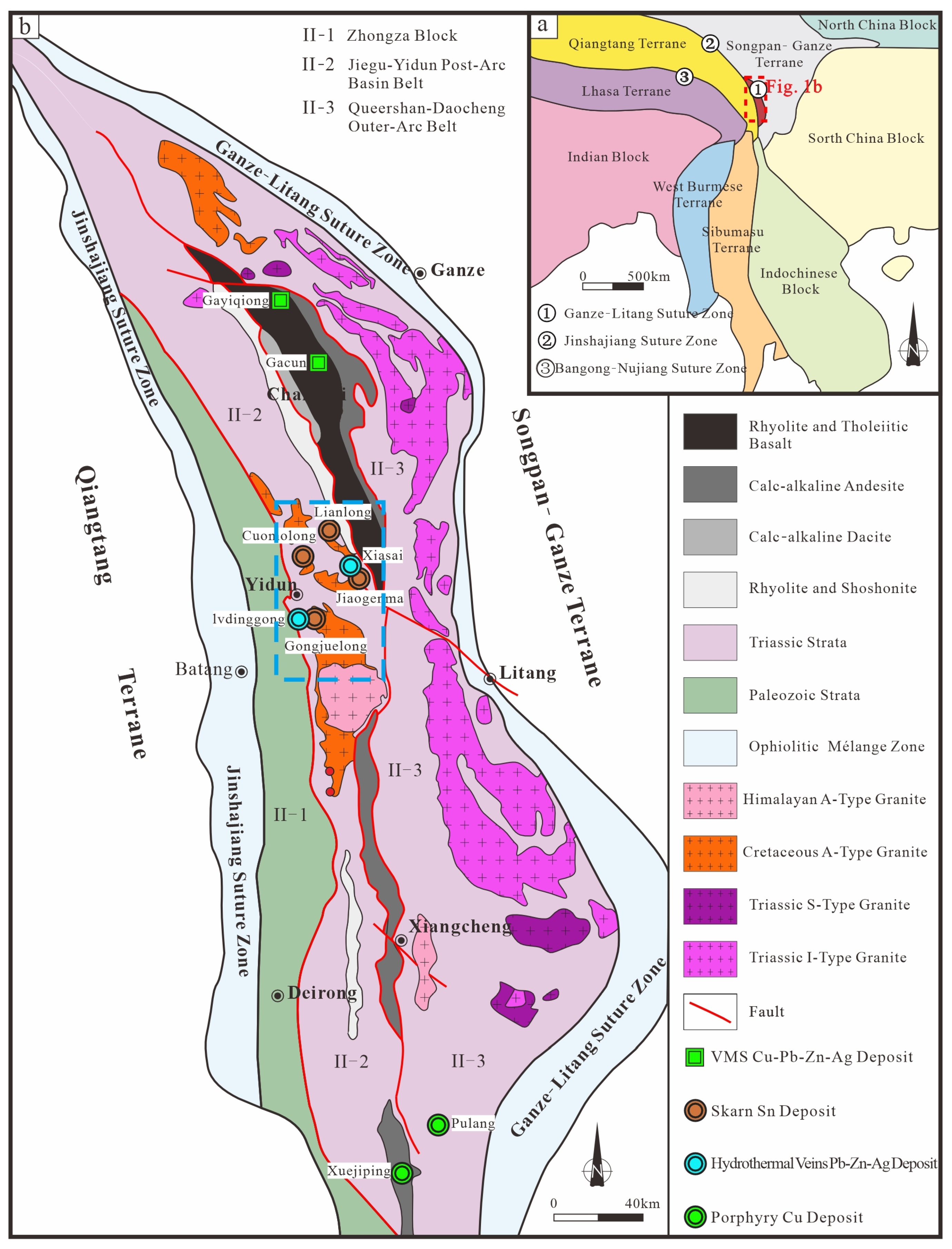

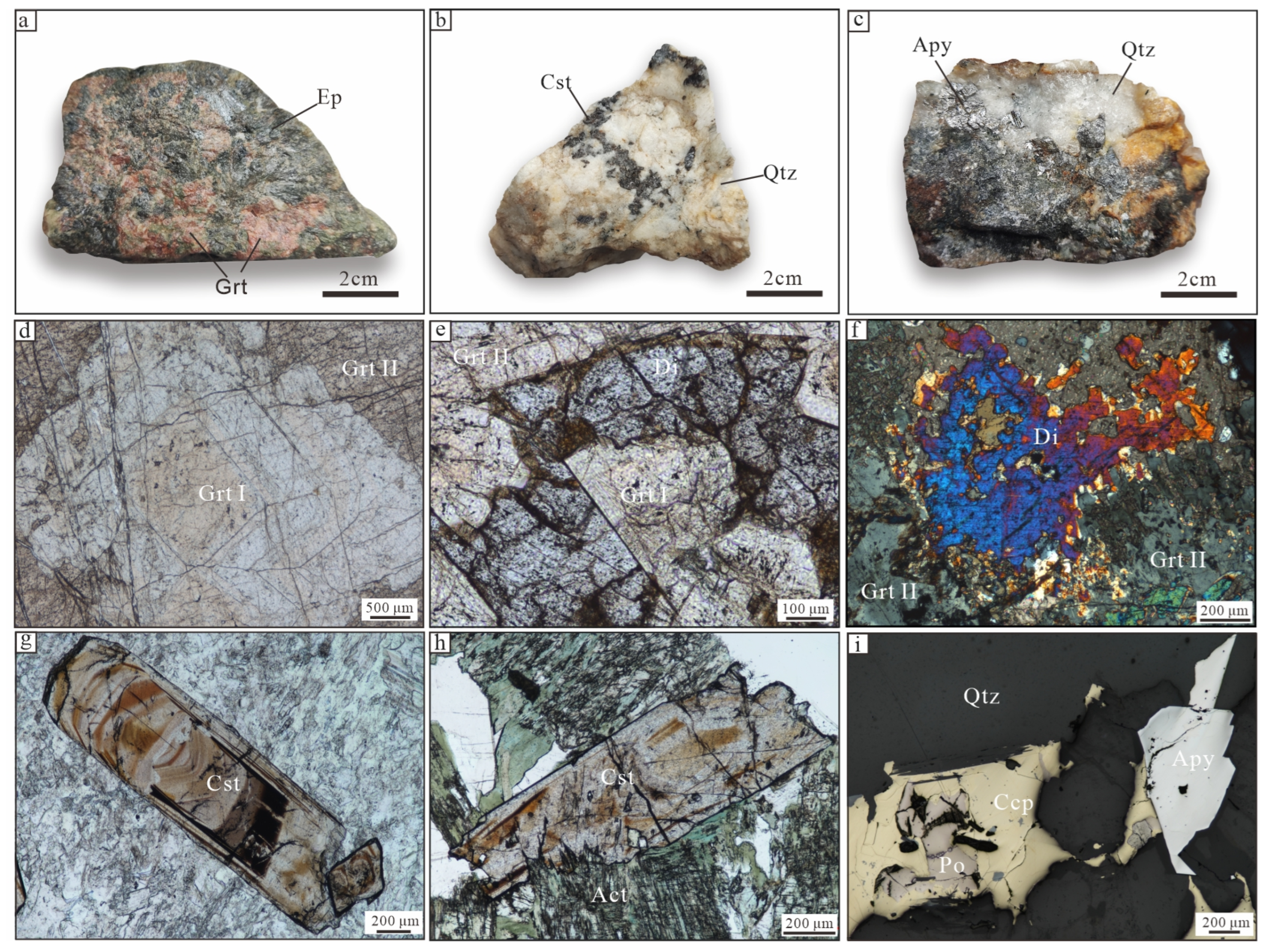
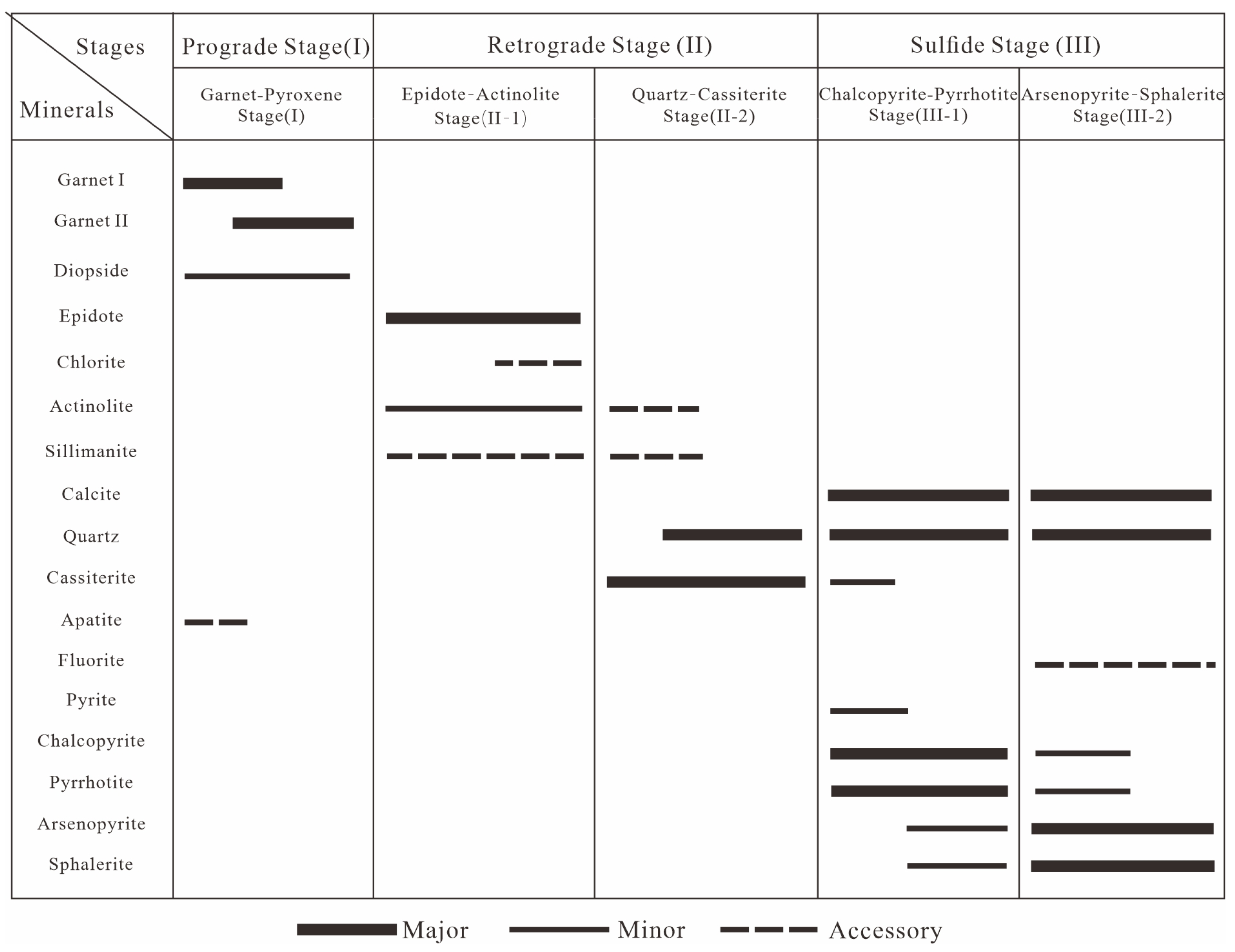
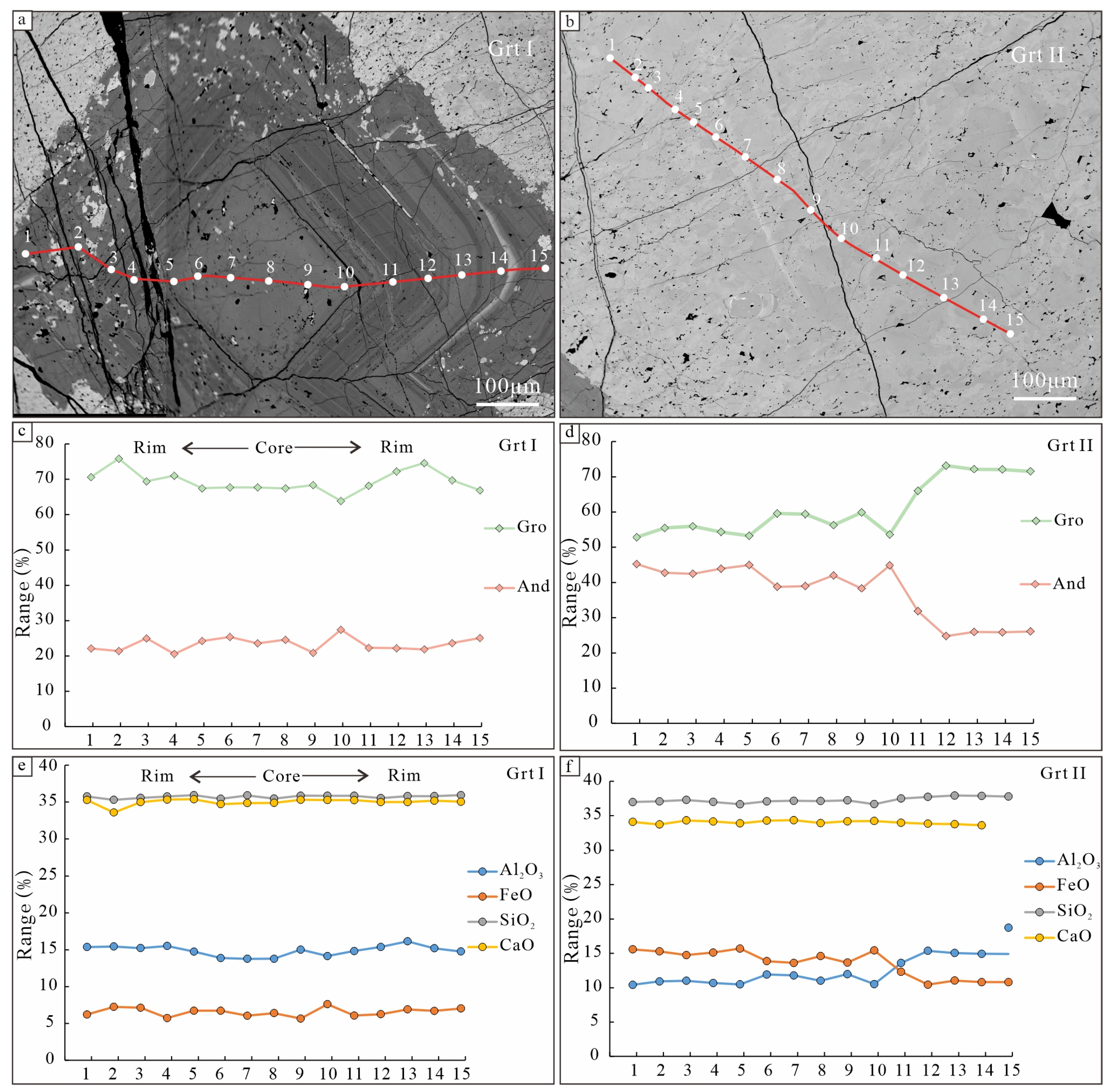

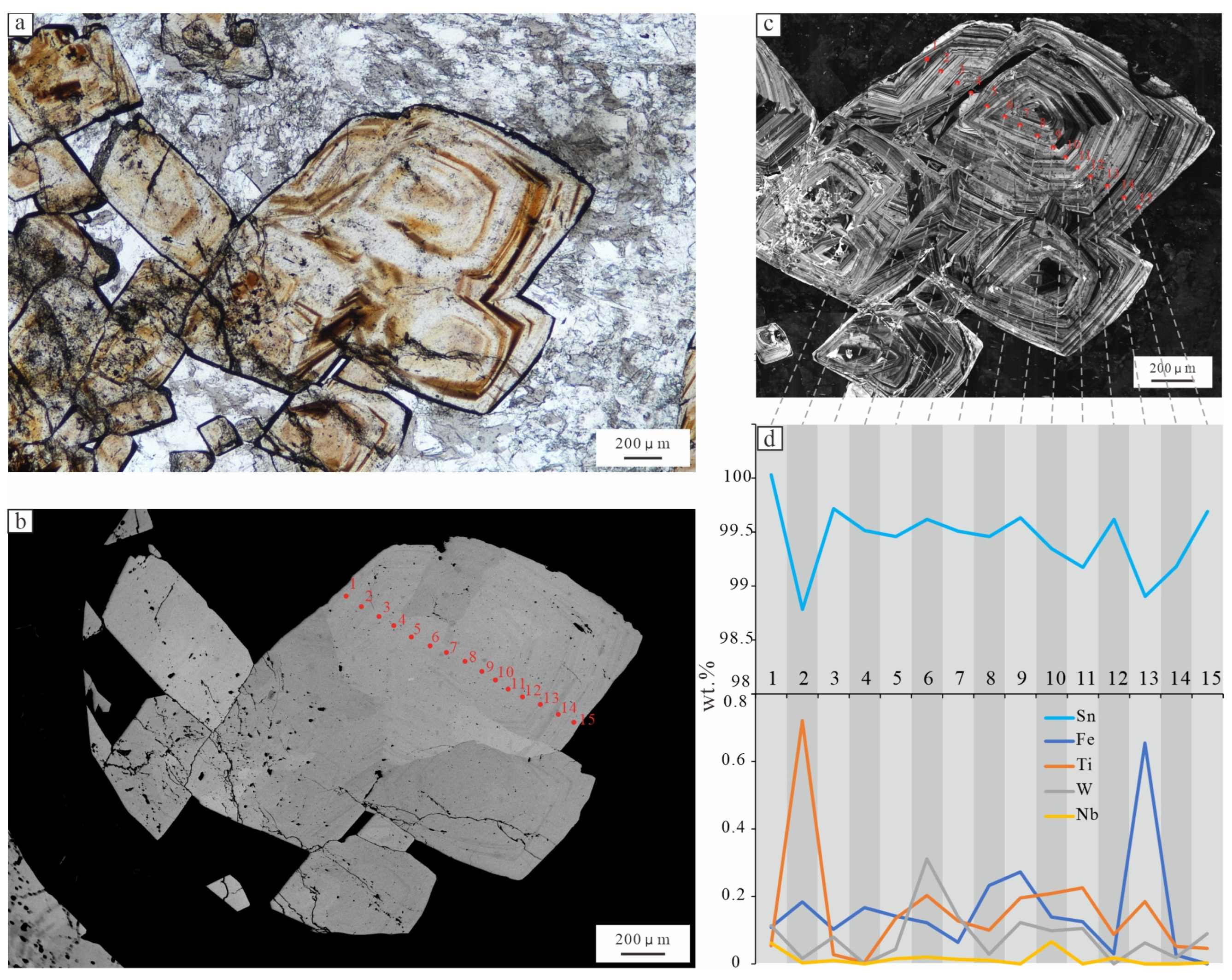
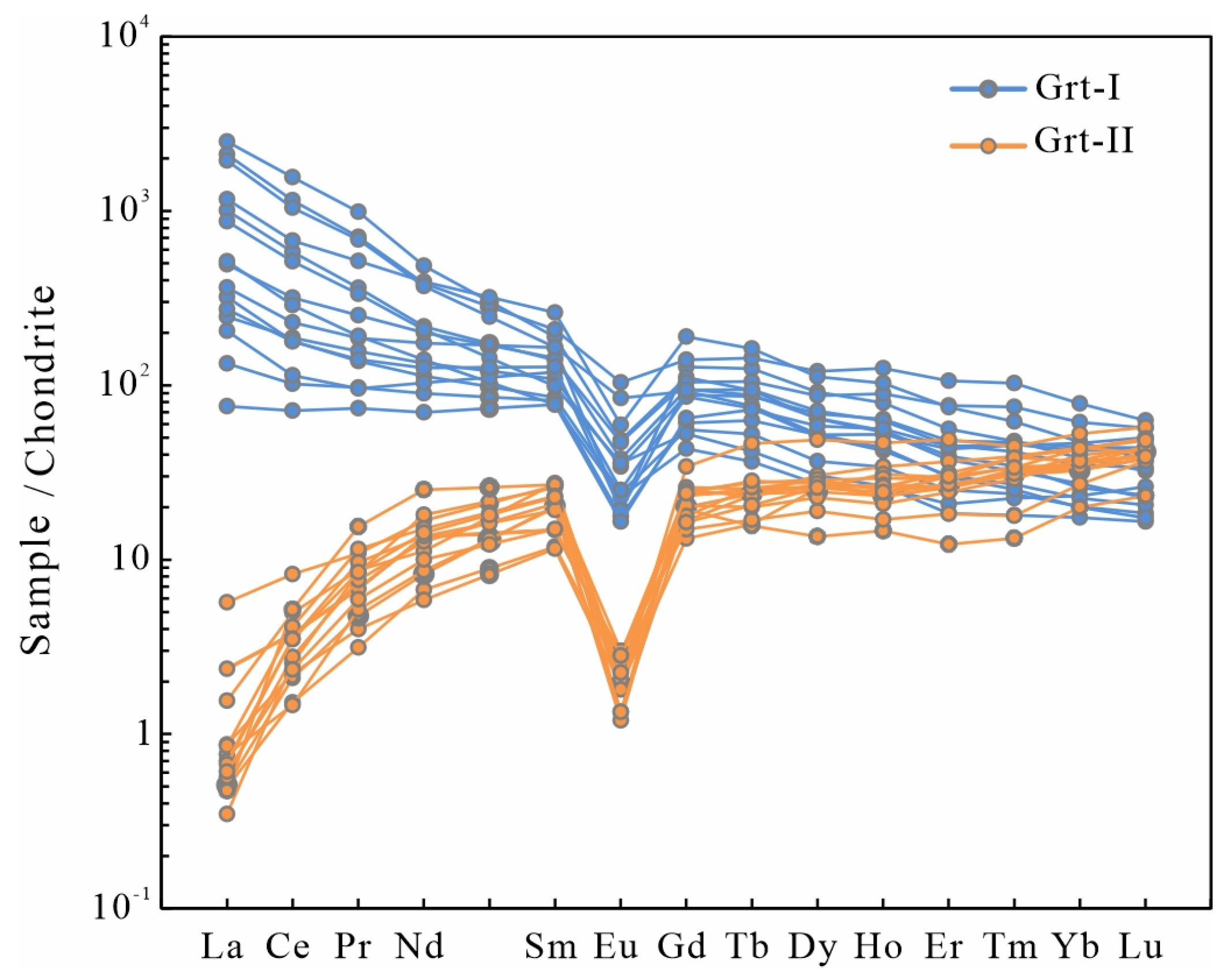

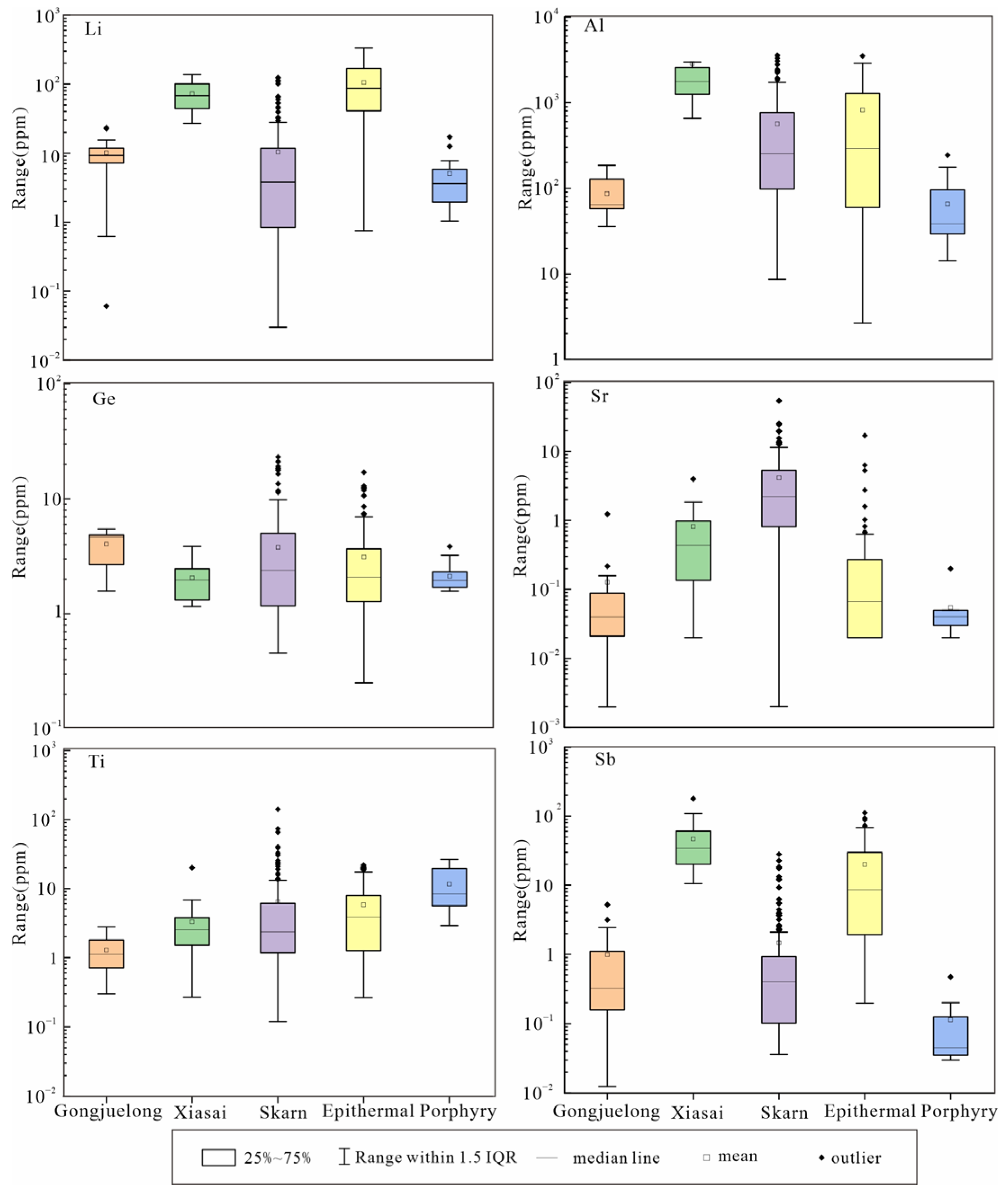
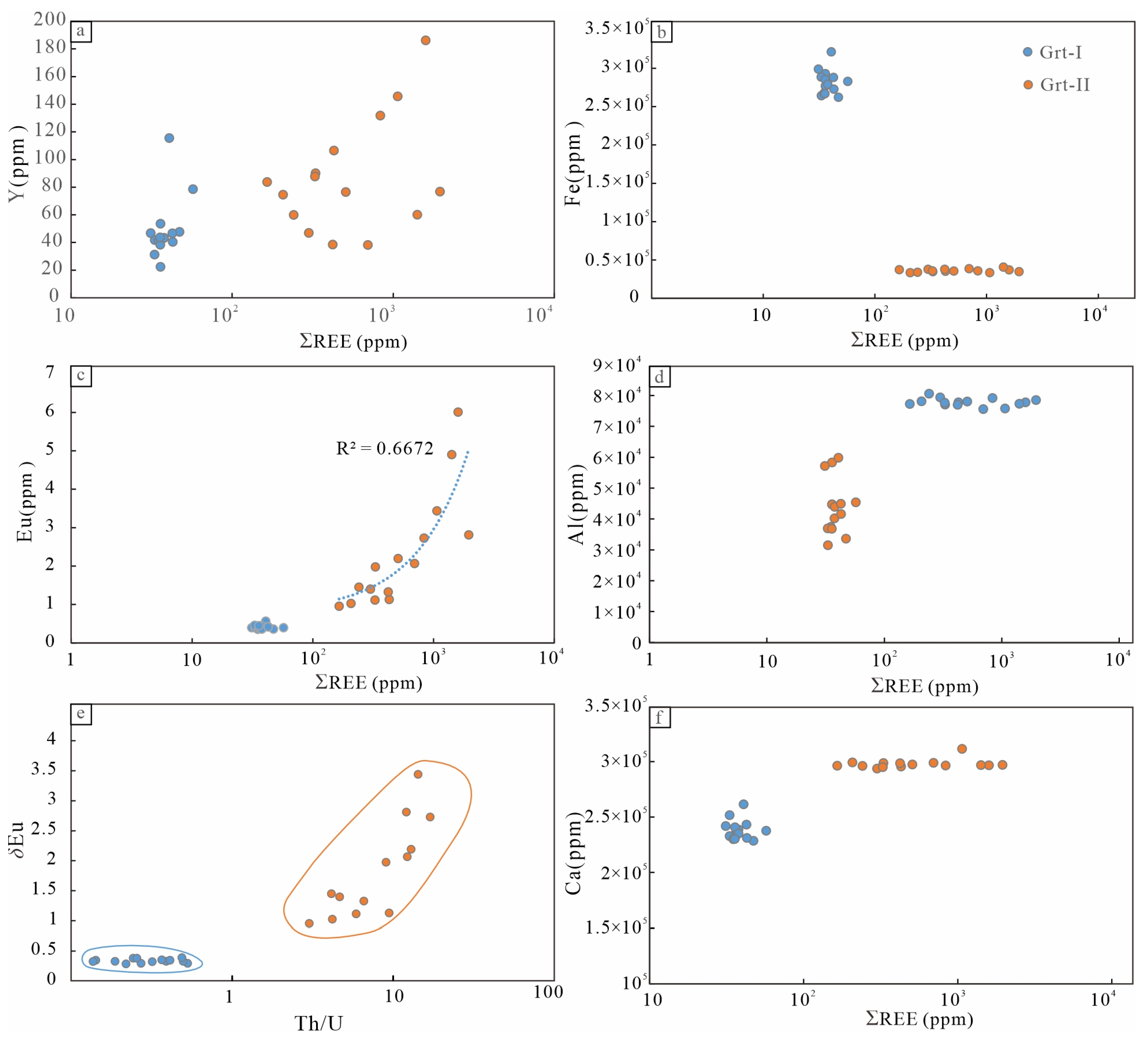
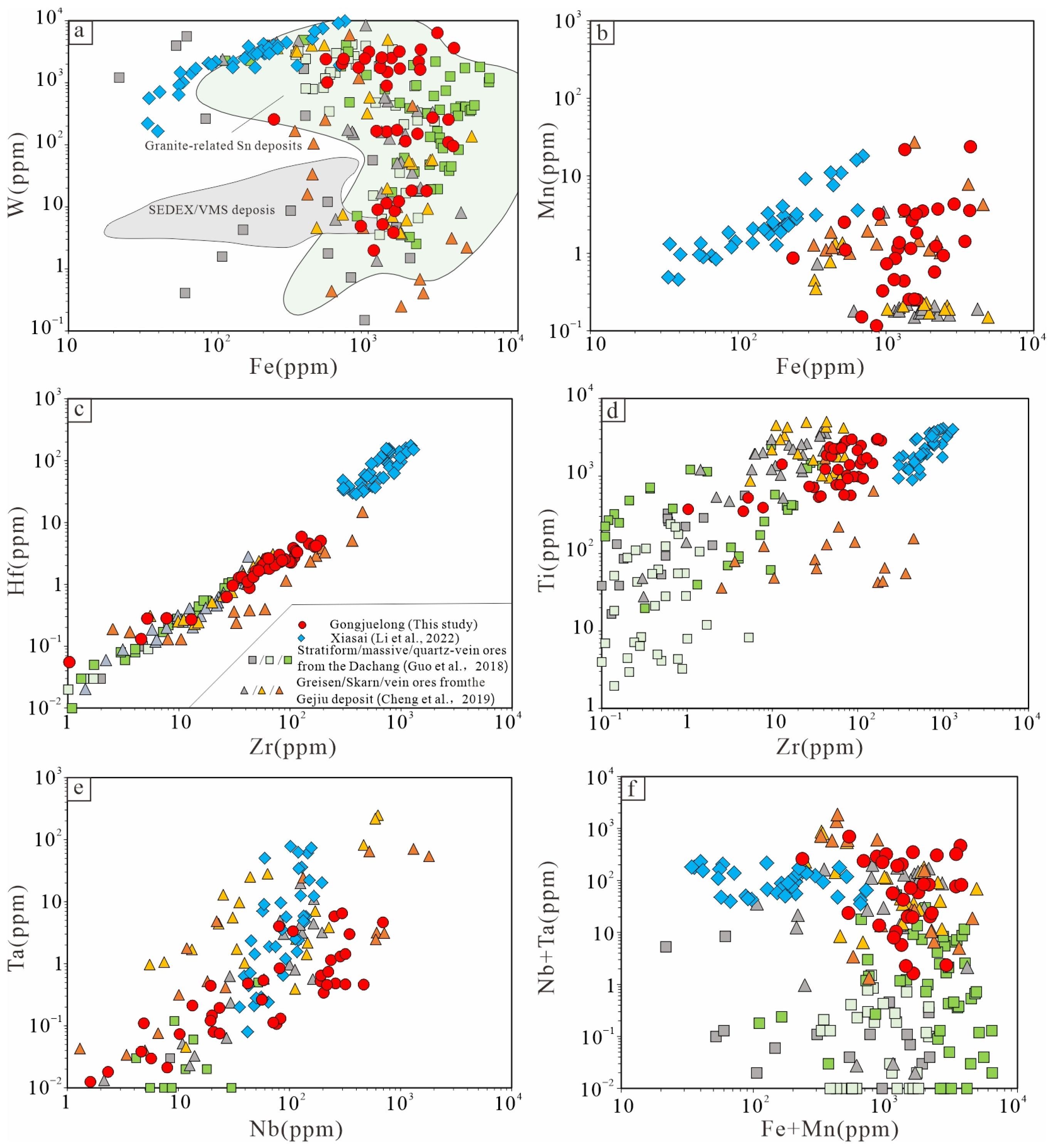
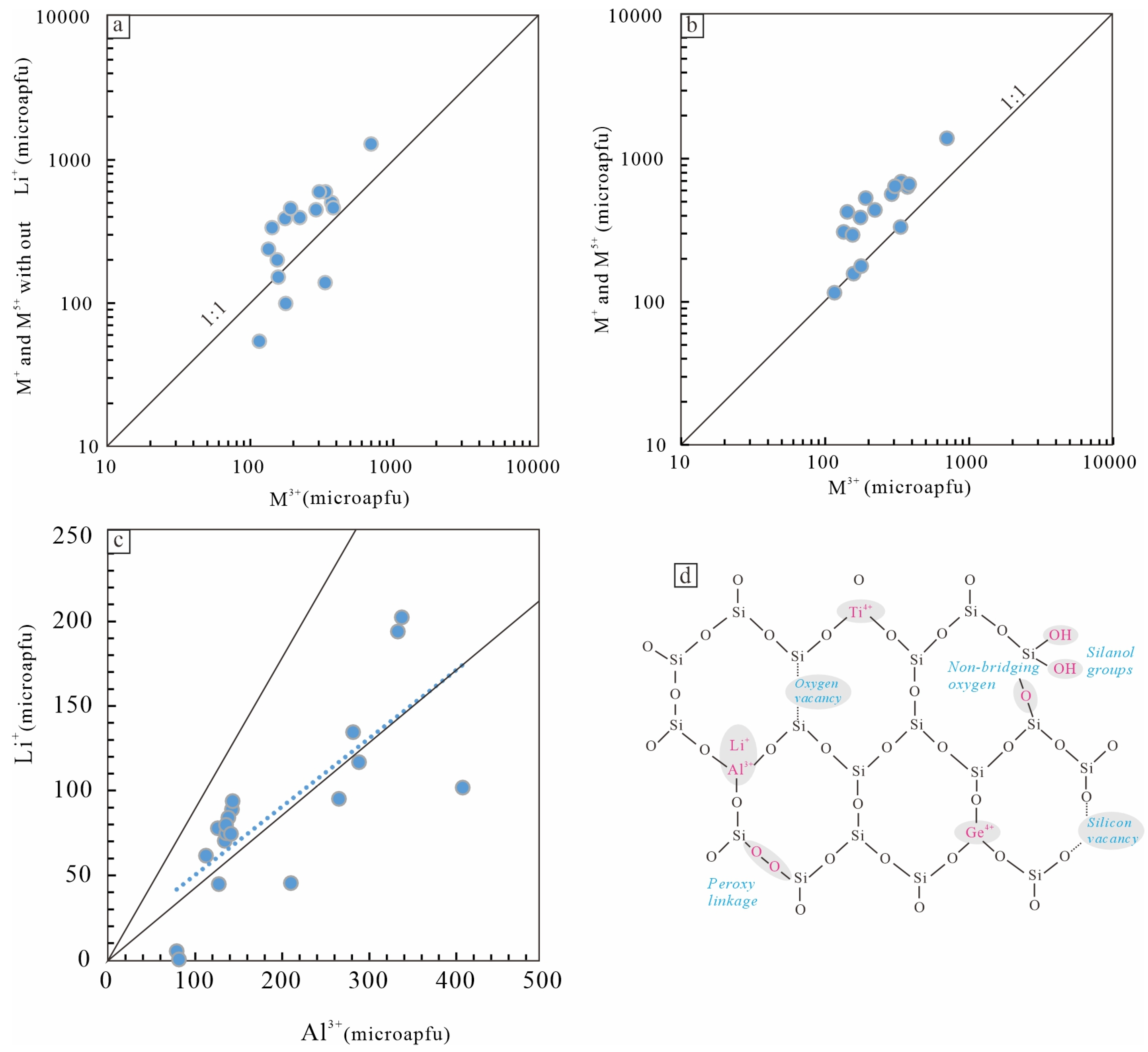
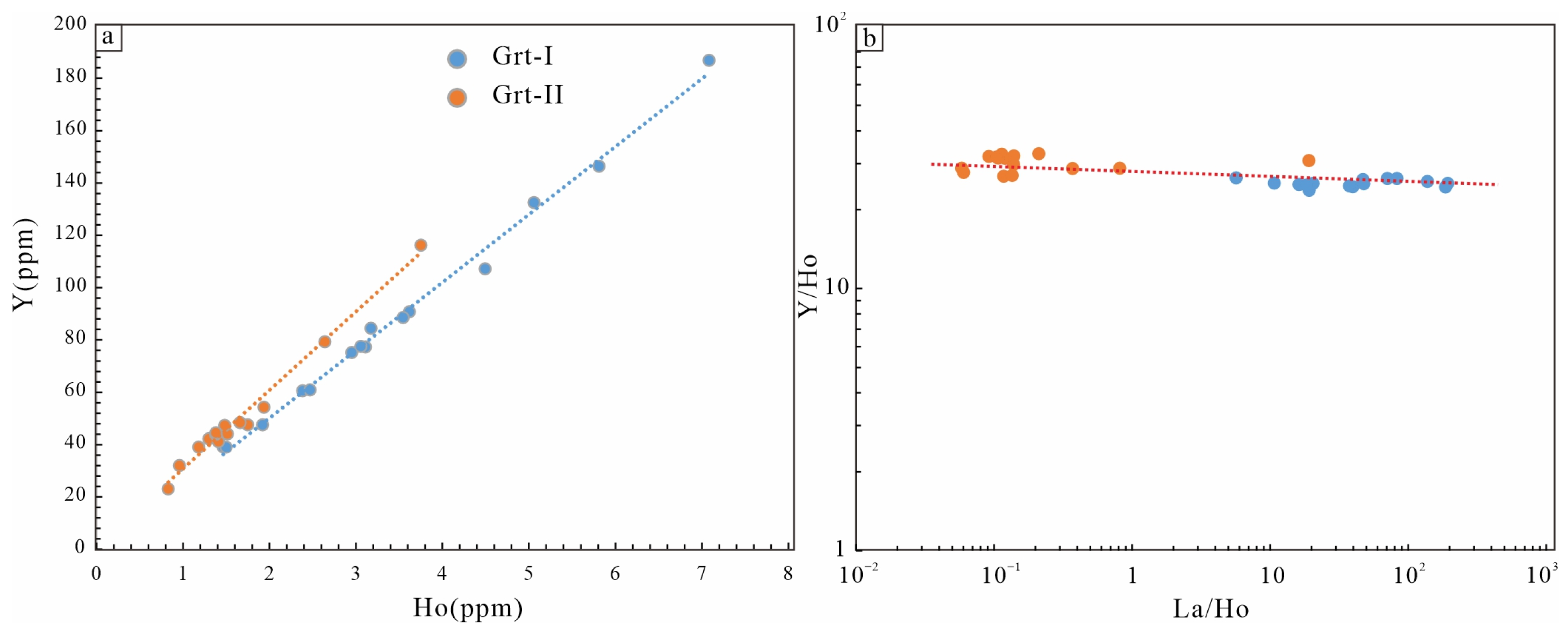

| Type | Location | Host Rock | Mineralization Age | Mineral Assemblage | Sulfur Isotopes (‰) | Lead Isotopes | Hydrogen and Oxygen Isotopes of Quartz (‰) | Fluid Inclusions | Reference | |
| Th (°C) | Salinities (wt%) | |||||||||
| Gongjuelong skarn Sn deposit | Situated within the contact zones between granite and Triassic carbonate rocks. | Skarns, marble, or hornfels | Cassiterite U-Pb 97 ± 2 Ma | Ore minerals include cassiterite, chalcopyrite, pyrrhotite, and arsenopyrite, with minor sphalerite and pyrite. | δ34S = (−6.74)–(−3.56) | 206Pb/204Pb = 18.182–18.826 | δDV-SMOW = (−117)–(−98.4) δ18O = 1.1–1.8(unpublished) | [77] | ||
| 207Pb/204Pb = 15.575–15.704 | Quartz: 172.6–232.1 | 5.2–13.6 | ||||||||
| 208Pb/204Pb = 38.444–39.083 | ||||||||||
| Xiasai hydrothermal vein type Ag–Pb–Zn deposit | Occurs within the metamorphosed sandstone and shale that are located distal to the causative granite intrusions. | Sandstones, carbonate rock, and siliceous slate | sphalerite Rb–Sr 99 ± 3 Ma | Cassiterite, arsenopyrite, pyrrhotite, chalcopyrite, sphalerite, galena, Ag-bearing minerals, and native bismuth. | δ34S = (−10.1)–(−1.2) | 206Pb/204Pb = 18.711–18.748 | Quartz from sub-stage II-2 δDV-SMOW= −104, δ18O = 8.4 | Quartz from stage I: 423–481 | 14.9–19.0 | [4] |
| 207Pb/204Pb = 15.711–15.752 | Quartz from sub-stage II-3 δDV-SMOW = (−105)–(−138), δ18O = (−3.3)–(−0.9) | Quartz from stage II-1: 285–386 | 3.5–8.0 | |||||||
| 208Pb/204Pb = 39.104–39.225 | Quartz from stage II-3: 158–242 | 3.4–5.7 | ||||||||
Disclaimer/Publisher’s Note: The statements, opinions and data contained in all publications are solely those of the individual author(s) and contributor(s) and not of MDPI and/or the editor(s). MDPI and/or the editor(s) disclaim responsibility for any injury to people or property resulting from any ideas, methods, instructions or products referred to in the content. |
© 2025 by the authors. Licensee MDPI, Basel, Switzerland. This article is an open access article distributed under the terms and conditions of the Creative Commons Attribution (CC BY) license (https://creativecommons.org/licenses/by/4.0/).
Share and Cite
Zhou, Y.; Peng, Y.; Liu, C.; Tian, J.; Wang, Z.; Song, M.; Zhang, Y. Genesis of the Gongjuelong Sn Polymetallic Deposit in the Yidun Terrane, China: Constraints from the In Situ Geochemistry of Garnet, Cassiterite, and Quartz. Minerals 2025, 15, 314. https://doi.org/10.3390/min15030314
Zhou Y, Peng Y, Liu C, Tian J, Wang Z, Song M, Zhang Y. Genesis of the Gongjuelong Sn Polymetallic Deposit in the Yidun Terrane, China: Constraints from the In Situ Geochemistry of Garnet, Cassiterite, and Quartz. Minerals. 2025; 15(3):314. https://doi.org/10.3390/min15030314
Chicago/Turabian StyleZhou, Yuchang, Yiwei Peng, Chang Liu, Jianji Tian, Zhi Wang, Mingwei Song, and Yan Zhang. 2025. "Genesis of the Gongjuelong Sn Polymetallic Deposit in the Yidun Terrane, China: Constraints from the In Situ Geochemistry of Garnet, Cassiterite, and Quartz" Minerals 15, no. 3: 314. https://doi.org/10.3390/min15030314
APA StyleZhou, Y., Peng, Y., Liu, C., Tian, J., Wang, Z., Song, M., & Zhang, Y. (2025). Genesis of the Gongjuelong Sn Polymetallic Deposit in the Yidun Terrane, China: Constraints from the In Situ Geochemistry of Garnet, Cassiterite, and Quartz. Minerals, 15(3), 314. https://doi.org/10.3390/min15030314






